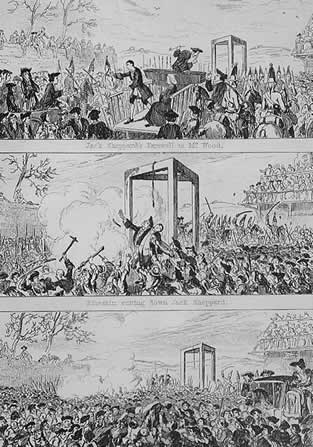November 16th 1724: Jack Sheppard, Stepney born highwayman & housebreaker, was hanged at Tyburn in front of 200,000 spectators. Born into a poor family, he was apprenticed as a carpenter but took to theft and burglary.
He was arrested and imprisoned five times in 1724 but escaped four times from prison, making him a notorious public figure, and wildly popular with the poorer classes.
By the time Sheppard's execution cart arrived at Tyburn, Jack was almost insensible from the vast quantity of grog and ale given to him at several inns and taverns as their traditional sending-off gift of 'One More For The Road', by some accounts, Sheppard had to be supported for the noose to be placed.
Sheppard's life story was an inspiration for William Hogarth's 1747 series of 12 engravings, titled 'Industry and Idleness', which shows the descent of an apprentice into crime and eventually to the gallows.
The Amazing Escapes of Jack Sheppard
Jack Sheppard was the 18th century’s most notorious robber and thief. His spectacular escapes from various prisons, including two from Newgate, made him the most glamorous rogue in London in the weeks before his dramatic execution.
Jack Sheppard (4 March 1702 – 16 November 1724) was born into a poor family in Spitalfields in London, an area notorious for highwaymen, villains and prostitutes in the early 18th century. He was apprenticed as a carpenter and by 1722, after 5 years of apprenticeship, he was already an accomplished craftsman, with less than a year of his training left.
Now 20 years old, he was a small man, 5’4″ tall and slightly built. His quick smile, charm and personality apparently made him popular in the taverns of Drury Lane, where he fell in with bad company and took up with a prostitute called Elizabeth Lyon, also known as ‘Edgworth Bess’.
He threw himself wholeheartedly into this shady underworld of drinking and whoring. Inevitably, his career as a carpenter suffered, and Sheppard took to stealing in order to boost his legitimate income. His first recorded crime was for petty shoplifting in spring 1723.
Jack Sheppards first escape CCIt was not long before he met and fell in with local villain Joseph Blake, known as ‘Blueskin’. His crimes escalated. He was arrested and imprisoned five times between 1723 and 1724 but escaped four times, making him notorious yet extremely popular especially amongst the poor.
His First Escape, 1723.
Sent to St Anne’s Roundhouse for pick-pocketing, he was visited there by Bess Lyon who was recognised and also arrested. They were sent together to New Prison in Clerkenwell and were locked in a cell known as The Newgate Ward. The next morning Sheppard filed off his fetters, made a hole in the wall and removed an iron bar and a wooden bar from the window. Tying sheets and blankets together, the pair lowered themselves to the ground, Bess going first. They then climbed over a 22-foot-high wall to make good their escape, quite a feat considering Jack was not a tall man and Bess was quite a large, buxom woman.
His Second Escape, 30th August 1724.
In 1724, having been convicted of burglary, Jack Sheppard found himself under sentence of death. In Newgate in those days there was a hatch with large iron spikes opening into a dark passage,
which led to the condemned cell. Sheppard filed away one of the spikes so that it would easily break off. In the evening two visitors, Bess Lyon and another prostitute, Moll Maggot, came to see him. They distracted the guard whilst he removed the spike, pushed his head and shoulders through the space and with the help of the two women, made his escape. This time his slight frame was to his advantage.
He was however, not free for long.
His Last and Most Famous Escape, 15th October 1724
Jack Sheppards third escape CCJack Sheppard made his most famous escape, again from Newgate Prison, between the hours of 4pm and 1am on 15th October. He succeeded in slipping off his handcuffs and with a crooked nail, picked the padlock securing his chain to the floor. Forcing several locks, he scaled a wall and reached the roof of the prison. Returning to his cell for a blanket, he then used it to slide down the roof and onto a neighbouring roof. Climbing into the house, he escaped through the front door, still wearing his leg irons.
He persuaded a passing shoemaker to remove the leg irons but was later apprehended, less than two weeks later, too drunk to resist arrest.
Daniel Defoe, the author of Robinson Crusoe, was so entranced by Jack Sheppard’s daring escapes that he ghostwrote his autobiography, A Narrative of all the Robberies, Escapes etc. of John Sheppard, in 1724.
Sheppard was convicted and sentenced to be hanged at Tyburn, ending his short criminal career. He was such a popular rebel hero that the route to his execution was lined by weeping women dressed in white and throwing flowers.
However Sheppard had planned one last great escape – from the gallows.
In a scheme involving Daniel Defoe and Appleby, his publisher, it was planned that they would retrieve the body after the requisite 15 minutes on the gallows and try to revive him, as in rare cases it was possible to survive a hanging. Unfortunately the crowd were unaware of this plan. They surged forward and pulled on his legs to ensure their hero a swift and less painful death. He was buried that night in the graveyard of St Martin-in-the-Fields.
Sheppard was famous for his daring escapes from prison. So much so, popular plays were written and performed after his death. The character of Macheath in John Gay’s The Beggar’s Opera (1728) was based on Sheppard. Then in 1840 William Harrison Ainsworth wrote a novel called Jack Sheppard. This novel was so popular that the authorities, in case people should be incited to crime, refused to license any plays in London with “Jack Sheppard” in the title for a further forty years.






No comments:
Post a Comment